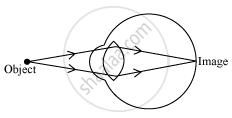Advertisements
Advertisements
प्रश्न
With the help of ciliary muscles the human eye can change its curvature and thus alter the focal length of its lens. State the changes that occur in the curvature and focal length of the eye lens while viewing (a) a distance object, (b) nearby objects.
उत्तर
(a) When we see distant object, the ciliary muscles relax/expand to decrease the curvature and there by increase the focal length of the lens. Hence, the lens becomes thin. This enables us to see the distant object clearly. Thus, the focal length of the eye lens increases while seeing distant objects.

(b) To see the nearby objects clearly, the focal length of the lens should be shorter. For this, the ciliary muscles contract to increase the curvature and thereby decrease the focal length of the lens. Hence, the lens becomes thick. This enables you to see the nearby objects clearly.

APPEARS IN
संबंधित प्रश्न
Define the term.
Power of accommodation of the eye.
Give the scientific names of the following parts of the eye:
a clear window at the front of the eye.
Which of the following changes occur when you walk out of bright sunshine into a poorly lit room?
(a) the pupil becomes larger
(b) the lens becomes thicker
(c) the ciliary muscle relaxes
(d) the pupil becomes smaller
Mention if the following statement is true (T) or false (F) Give reason.
Short-sightedness and hyperopia are one and the same thing
Sometimes you remember a vivid picture of a dream you saw. What is the role of your eyes in this experience?
______ of the eye is comparable to the film of a camera.
Describe the parts in the external structure of the eye.
Match the following:
| Column - I | Column - II |
| 1. Retina | a. Path way of light |
| 2. Pupil | b. Far point comes closer |
| 3. Ciliary muscles | c. near point moves away |
| 4. Myopia | d. Screen of the eye |
| 5. Hypermetropia | e. Power of accommodation |
Name the following:
The fibres which collectively hold the lens in position.
Where is the following located?
Yellow spot
